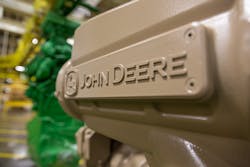By instilling a mix of innovation, ingenuity and state-of-the-art technology into each tractor, combine or planter, John Deere has made a name for itself as a leading producer of smart agricultural equipment. As a result, the company empowers today's farmers to efficiently utilize every inch of useable land.
Of course, producing such technologically advanced equipment requires a significant dedication to manufacturing technology well before it ever reaches a farmer’s field. Simply put, it requires a commitment to Industry 4.0 and constantly looking for ways to improve operations.
This is ultimately what drove John Deere to participate in the FCC’s auction to acquire 5G spectrum this summer. The company had its eye on the opportunities the latest technology could enable within the digital manufacturing space.
"We want to optimize our digital environments – and not only what's here now, we want to be ready as technology continues to accelerate," says John Deere’s Manager of Manufacturing Innovation and Technology Strategy Craig Sutton. "After looking at the available spectrum space, it was the right opportunity to make investments in some strategic locations where Deere has some of its larger manufacturing facilities.”
Specifically, with its win at the auction, John Deere will now implement 5G (with rollouts during fiscal year 2022) at its manufacturing facilities in the following counties: Rock Island, Illinois; Scott County, Iowa; Dubuque, Iowa; Polk County, Iowa; Black Hawk County, Iowa.
Enabling flexibility
John Deere’s manufacturing facilities are extraordinarily complex environments that rely on automation and connectivity. With miles of embedded Ethernet cables connecting Wi-Fi drop points currently in factory ceilings, the facilities are faced with limited flexibility for set up and upgrades. 5G enabled by private networks will allow John Deere to design a more flexible, nimble and connected facility, creating opportunity for further advancement and greater efficiency that will transform the manufacturing process.
Sutton shared his excitement with IndustryWeek about how John Deere is going to be able to use a 5G backbone to drive value in its operations, as the manufacturing team explores the many uses cases. “We are excited about the digital transformation occurring inside our factories, where we're going to see a lot more connected devices, and automation whether its robots or autonomous mobility solutions,” he says. “We also see a lot of different technology coming forward including advanced vision systems. All these connected devices translate to more data transmissions and the need for quicker and faster decision making. The 5G infrastructure is the most viable paths to enable these trends.”
However, making environment changes often translates to significant work. In fact, each new product John Deere introduced to the market in the last year had significant floorspace redesigns. "Maybe we add new features into a product line, maybe we just make some adjustments. When you make one of those moves in a work cell or a change on your shop floor, IT infrastructure is crucial, which means pulling and dropping cables and maybe adding in different devices," he says. "Unfortunately, those activities eat away at our efficiencies. 5G is a way to improve."
Strategic move
John Deere did not decide to invest in 5G using a siloed approach. Instead, the decision was the result of strategic discussion with the company’s customer facing Intelligence Solutions Group. "This was an opportunity to look at how 5G could impact John Deere products as well as manufacturing processes. We worked as a team with some amazing engineers who know a lot about networks, spectrum and connectivity,” he says. “They played a key role in helping us through these decisions as it relates to manufacturing. These same network engineers who are coming into our factories to create strategies around effectively lighting up 5G spaces.”
“John Deere has always focused on how to empower customers to do more with less by using technology, and our focus on tech goes way beyond the fields. It impacts everything single aspect of our business, and we’re constantly looking at ways to improve our own efficiencies and outcomes with it,” said John Deere CTO Jahmy Hindman in a statement. “Implementing 5G in our manufacturing facilities allows John Deere to make significant progress in our Smart Industrial strategy by turning factories into smart and connected manufacturing facilities – a critical piece of the industrial IoT.”
Although the plan is to build a private 5G network, Sutton still sees partners playing a meaningful role, especially in areas where the company has factories yet did not bid on spectrum. “We also know some commercial partner strategies had a much longer timeline to put 5G solution sets into the locations where Deere has its larger facilities. While these are strategic locations for John Deere, they most likely do not align with initial locations for the commercial industry,” he says. “Plus, since spectrum is just one part of the equation, hardware partners will understandably play a pivotal role.”
Private 5G technology also creates the opportunity to expand factory capabilities leveraging edge computing, analytics, and autonomous devices, and empowers a larger set of smart applications like real- time location systems, asset tracking, inventory management, wearables, building automation, and robotics for operational cost savings.
Looking forward, Sutton is clear in pointing out that 5G is one of many pieces in the puzzle for John Deere. “Our investment in 5G fits into a larger strategy around driving new efficiencies and digital transforming our operations,” he says. “We see 5G as an underlying infrastructure technology better enabling solution sets as we continue to build out our industrial IoT.”







